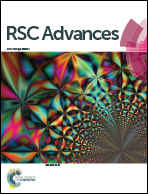Preparation and characterization of stereocomplex aggregates based on PLA–P188–PLA†
Abstract
Novel dumbbell-shaped amphiphilic copolymers ((PLLA)2–G1–P188–G1–(PLLA)2 and (PDLA)2–G1–P188–G1–(PDLA)2) and linear-shaped amphiphilic copolymers (PLLA–P188–PLLA and PDLA–P188–PDLA) were synthesized by click chemistry and ring opening polymerization (ROP). The stereocomplexes (scPLA)2–G1–P188–G1–(scPLA)2 and scPLA–P188–scPLA were prepared and confirmed by X-ray diffraction (XRD). The stereocomplex interaction between PLLA and PDLA was firstly analyzed using microscale thermophoresis (MST) technology and the dissociation constant (Kd) was obtained as 342 μM. The aggregation behaviors of these stereocomplexes were studied using fluorescence spectroscopy, transmission electron microscopy (TEM) and light scattering (LS). The critical aggregate concentration (CAC) obtained from fluorescence measurements was 0.021 mg mL−1 for (scPLA)2–G1–P188–G1–(scPLA)2 and 0.042 mg mL−1 for scPLA–P188–scPLA. These stereocomplexes can self-associate in aqueous solution into spherical aggregates with a diameter of 181 nm for (scPLA)2–G1–P188–G1–(scPLA)2 and 222 nm for scPLA–P188–scPLA. Furthermore, the biocompatibility of the stereocomplexes was evaluated with a relatively lower cytotoxicity. Finally, DOX was encapsulated into the stereocomplex aggregates to evaluate the drug release ability in phosphate buffer at a pH value of 7.4 or 5.4. The drug loading content and the encapsulation efficiency of the aggregates are 9.8%, 54% for (scPLA)2–G1–P188–G1–(scPLA)2 and 8.2%, 45% for scPLA–P188–scPLA. The release of DOX at pH 5.4 is faster than that at pH 7.4. The pH value has a greater effect on the release rate of DOX from dumbbell-shaped stereocomplex aggregates than that from the linear-shaped ones, which ensures the long blood circulation and the higher DOX-release surrounding the tumor site.


 Please wait while we load your content...
Please wait while we load your content...